6 Effective Tips on How to Prevent Gum Disease

Gum disease develops as a moderate condition known as gingivitis. This is the stage at which the gums get red, swell, and bleed. If left untreated, it can lead to periodontitis. This more severe type of condition leads the gums to recede, exposing more of the tooth, and leaving spaces for bacteria to thrive. The teeth may become loose and fall out as a result of bone loss.
Gum disease is preventable. By changing a few behaviors and being more persistent in your dental care, you can avoid significant oral health concerns. Your dentist can help you avoid this issue and cure it if it develops. Here is a list of six effective tips on how to prevent gum disease.
1. Brush your teeth thoroughly
Proper toothbrushing is the first step in keeping your teeth clean and healthy. Brushing twice a day for two minutes at a time will assist to keep plaque at bay. Spend 30 seconds on each quadrant of your mouth to make cleaning every tooth simpler (upper right side, upper left side, lower right side, lower left side).
It is essential to use the correct procedures to ensure that the teeth are cleaned properly and that the soft tissue surrounding them is not damaged. Angle the brush head towards the gums in gentle circular strokes. Clean all surfaces, as well as the gum line, as well as both the front and back of your teeth.
2. Use dental floss every day
Dental patients frequently mention to their dentist or hygienist that they don’t floss frequently enough. Flossing once a day can maintain your gums healthy. This practice will remove food and dirt from between teeth. It stops the gums from swelling and receding. Flossing can help people avoid tartar accumulation and the serious complications that might result.
3. Use s mouthwash
Therapeutic mouthwashes, which are often available over the counter, can help decrease plaque, prevent or minimize gingivitis, slow the formation of tartar, or a combination of these advantages, according to the ADA. Additionally, a rinse helps in the removal of food particles and debris from your mouth, while it is not an alternative for flossing or brushing. Look for the ADA seal, which indicates that the product has been determined to be effective and safe.
4. Replace your toothbrush when it shows signs of wear
As a general guideline, replacing a toothbrush every 3 to 6 months should maintain it in good enough form to thoroughly clean your teeth. Damaged or frayed toothbrushes can't clean the surface of your teeth properly and might cause gum injury.
Replacing your toothbrush on a regular basis also helps to keep it clean. Always thoroughly clean your toothbrush before storing it so it can air dry. If you've been sick, make sure to replace your toothbrush to avoid reintroducing bacteria into your mouth.
5. Drink enough water
In addition to being beneficial to your general health, water consumption also supports proper saliva production. Saliva promotes dental health by carrying food particles through your mouth, preventing the majority of them from being lodged in your teeth, where bacteria can thrive. It also keeps your mouth moist and healthy.
6. Visit a dentist regularly
Gum disease may go unnoticed by some people. The dentist will be able to diagnose the disease due to their knowledge and training. The dentist might evaluate the patient and look for indicators of gingivitis or periodontitis during semi-annual dental visits.
The hygienist will not only clean the gums and teeth, but the dentist will also advise you on how to brush and floss more efficiently. Going to the dentist's office on a regular basis will assist the patient to maintain these healthy practices.
Similar Articles
Maintaining your oral health is important not only for a bright, confident smile but also for your overall well-being.
The desire for a healthy smile drives approximately 4 million people toward teeth straightening procedures. When it comes to straightening teeth, lingual braces offer a discreet alternative to traditional braces and clear aligners.
As we grow older, our dental needs evolve significantly. The carefree days of childhood tooth fairy visits transform into the more complex world of adult dental care. After age 25, many adults begin to notice changes in their oral health.
Missing teeth can cause a wide range of oral health issues. Nonetheless, over 120 million Americans are missing at least one tooth, and the figure is anticipated to climb as time passes.
A dental emergency doesn’t make an appointment. It shows up unannounced and unapologetic, usually in the middle of the night or during a meal that was supposed to be fun
A dental emergency can strike fast and without warning—during dinner, in the middle of the night, or just before a big meeting.
A wide range of factors can have a direct effect on your oral health. A balanced diet is essential, as is good oral hygiene and regular dental examinations. Many individuals think that nutrition alone can't improve oral health.
The results of wearing Invisalign aligners look stunning, and they are way more convenient than traditional braces. However, no one speaks about what it feels like to wear the same pair of traces around 22 hours a day
Temporomandibular Joint Disorder, commonly known as TMJ, is a condition that causes pain and dysfunction in the jaw joint and surrounding muscles. This disorder can arise from various factors, including teeth grinding, arthritis, jaw injuries, poor posture, or stress.









